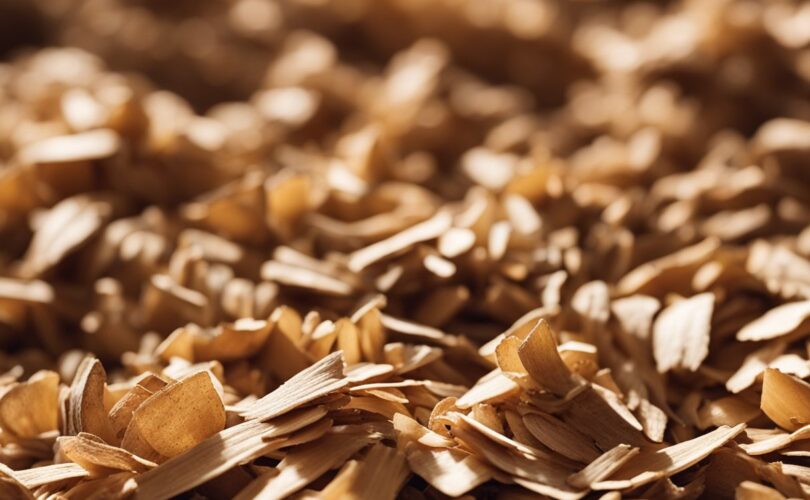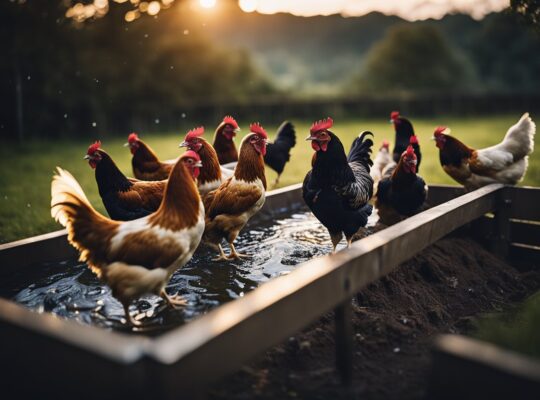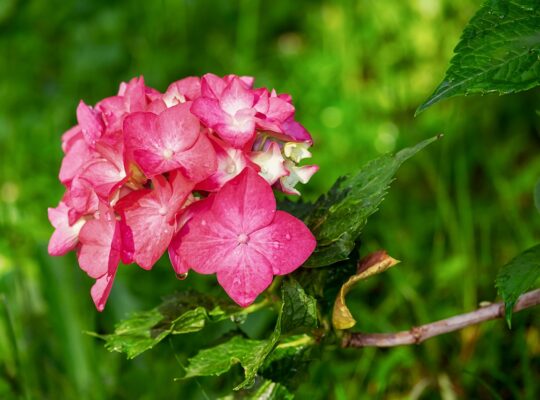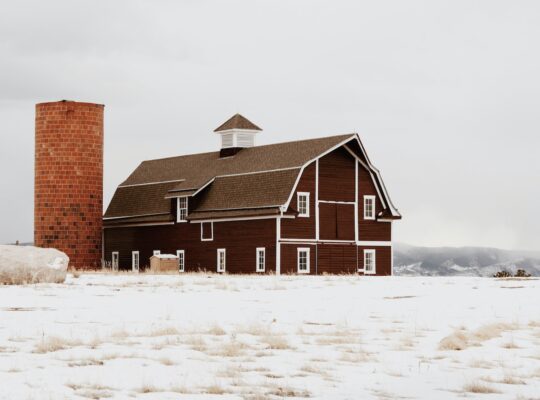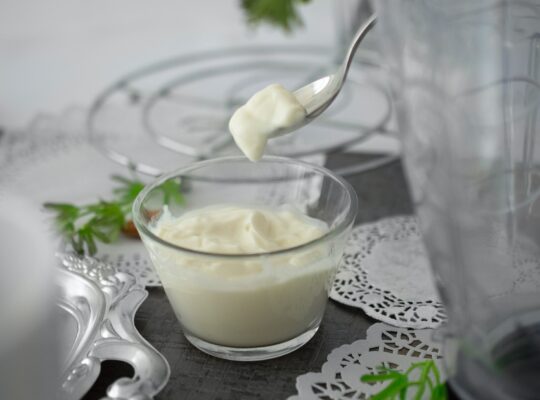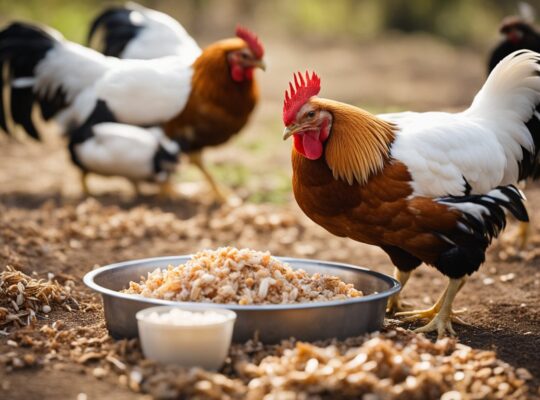Wood chips are a popular choice for chicken bedding due to their absorbency, availability, and affordability. However, you may be wondering if they are a suitable option for your flock. The answer is yes but with some caveats.
Firstly, it’s important to note that not all wood chips are created equal. Softwood chips, such as pine and cedar, are more absorbent and better at controlling odor than hardwood chips. However, they also contain natural oils that can be harmful to chickens if ingested in large quantities.
It’s important to use only a thin layer of softwood chips and supplement it with other bedding materials, such as straw or hay, to reduce the risk of ingestion.
Additionally, it’s important to keep in mind that wood chips can be dusty, which can irritate chickens’ respiratory systems. To minimize dust, choose larger chips and avoid using power tools to break them down. Overall, wood chips can be a suitable option for chicken bedding when used correctly, but it’s important to take precautions to ensure the health and safety of your flock.
Benefits of Using Wood Chips for Chicken Bedding
If you are considering using wood chips for chicken bedding, there are several benefits to keep in mind.
Absorbency
Wood chips are highly absorbent and can help keep your chicken coop clean and dry. They can absorb moisture and odor, which can help reduce the risk of bacterial growth and keep your chickens healthy.
Comfort
Wood chips provide a comfortable surface for chickens to walk on and can help prevent foot injuries. They also provide insulation, which can help keep chickens warm in the winter and cool in the summer.
Cost-Effective
Using wood chips for chicken bedding can be a cost-effective option, especially if you have a local source for them. They are often less expensive than other types of bedding materials, such as straw or sand.
Easy to Manage
Wood chips are easy to manage and can be easily replaced when they become soiled. They can also be composted, which makes them an environmentally friendly option.
Overall, using wood chips for chicken bedding can provide several benefits, including absorbency, comfort, cost-effectiveness, and ease of management.
Types of Wood Chips Suitable for Chicken Bedding

When it comes to chicken bedding, wood chips are a popular choice among poultry farmers. They provide a comfortable and absorbent surface for the birds to walk and rest on, and they also help to control odors and moisture in the coop.
Softwood Chips
Softwood chips are a popular choice for chicken bedding because they are inexpensive and readily available. They are also lightweight and easy to handle, making them a convenient option for farmers. Softwood chips are made from trees such as pine, spruce, and fir, and they have a pleasant aroma that can help to mask odors in the coop.
However, it’s important to note that softwood chips can be high in resin, which can cause respiratory problems for chickens. To avoid this issue, make sure to choose softwood chips that have been properly dried and aged. You can also mix softwood chips with other types of bedding material, such as straw or hay, to reduce the amount of dust in the coop.
Hardwood Chips
Hardwood chips are another option for chicken bedding, and they have some advantages over softwood chips. They are denser and heavier than softwood chips, which means they are less likely to blow around in the coop. They also break down more slowly than softwood chips, which means they can last longer as bedding material.
Hardwood chips are made from trees such as oak, maple, and hickory, and they have a higher lignin content than softwood chips. This means they break down more slowly and can provide a more stable surface for chickens to walk and rest on.
Hardwood chips can be more expensive than softwood chips, so they may not be the best choice for farmers on a tight budget.
Both softwood and hardwood chips can be suitable for chicken bedding, but it’s important to choose the right type of wood chips for your particular situation. Make sure to consider factors such as cost, availability, and respiratory issues when making your decision.
How to Prepare and Maintain Wood Chip Bedding
Preparation Process
If you’re considering using wood chips for chicken bedding, you’ll need to prepare the wood chips first. Here are the steps to follow:
- Choose the right type of wood chips: Not all wood chips are suitable for chicken bedding. Pine and cedar chips are two popular options, but avoid using black walnut chips as they can be toxic to chickens.
- Clean the wood chips: Before using the wood chips, make sure they are clean and free of debris. Remove any large pieces of bark or twigs, and rinse the chips with water if necessary.
- Let the wood chips dry: Once the wood chips are clean, spread them out in a sunny spot and let them dry completely. This will help prevent mold and bacteria growth in the bedding.
- Add the wood chips to the coop: Once the wood chips are dry, you can add them to the chicken coop. Spread them out evenly to create a layer that is at least 2 inches thick.
Maintenance Tips
Maintaining wood chip bedding is important to keep your chickens healthy and comfortable. Here are some tips to help you maintain your wood chip bedding:
- Spot clean regularly: Remove any wet or soiled wood chips regularly to prevent the buildup of ammonia and bacteria in the coop.
- Add fresh wood chips: As the wood chips break down and become soiled, add fresh chips to maintain a 2-inch layer of bedding.
- Keep the coop dry: Moisture can lead to mold and bacteria growth, so make sure the coop is well-ventilated and that water sources are not leaking.
- Use a dust bath: Chickens need to dust bathe to keep their feathers clean and healthy. Provide a separate area of dry dirt or sand for them to bathe in.
By following these preparation and maintenance tips, you can create a comfortable and healthy environment for your chickens with wood chip bedding.
Potential Concerns and Solutions
When using wood chips as bedding for chickens, there are a few potential concerns to keep in mind. However, with proper management, these concerns can be addressed and minimized.
Dust Issues
One of the main concerns with using wood chips for chicken bedding is the potential for dust. Dust can cause respiratory issues in both chickens and humans. To minimize dust, it is recommended to use larger wood chips instead of smaller ones. Additionally, keeping the bedding moist can help to reduce dust.
Mold Prevention
Another concern with using wood chips for chicken bedding is the potential for mold growth. Mold can cause respiratory issues and other health problems for both chickens and humans. To prevent mold growth, it is important to keep the bedding dry and well-ventilated. If mold does develop, it is important to remove and replace the affected bedding immediately.
Toxicity Considerations
When using wood chips for chicken bedding, it is important to consider the type of wood being used. Some types of wood, such as black walnut, can be toxic to chickens. It is recommended to use hardwoods, such as oak or maple, for chicken bedding. Additionally, it is important to avoid using wood that has been treated with chemicals or pesticides.
Using wood chips for chicken bedding can be a cost-effective and practical option. It is important to be aware of the potential concerns and take steps to address them. By using larger wood chips, keeping the bedding moist, preventing mold growth, and using hardwoods, you can provide a safe and comfortable environment for your chickens.

